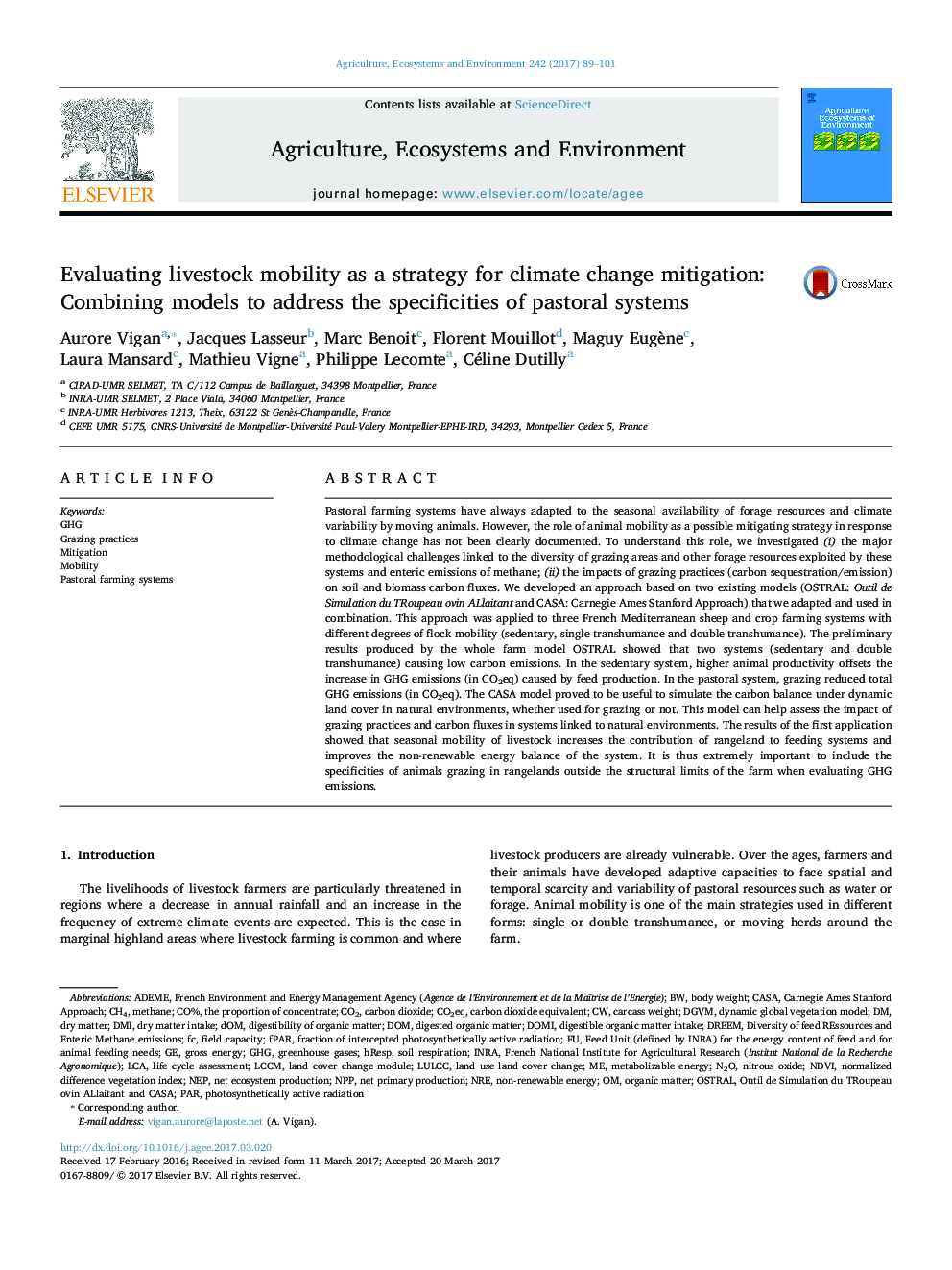| کد مقاله | کد نشریه | سال انتشار | مقاله انگلیسی | نسخه تمام متن |
|---|---|---|---|---|
| 5538143 | 1552010 | 2017 | 13 صفحه PDF | دانلود رایگان |
عنوان انگلیسی مقاله ISI
Evaluating livestock mobility as a strategy for climate change mitigation: Combining models to address the specificities of pastoral systems
ترجمه فارسی عنوان
ارزیابی تحرک دام ها به عنوان یک استراتژی برای کاهش تغییرات اقلیمی: ترکیب مدل ها برای رفع ویژگی های سیستم های گاو صندوق
دانلود مقاله + سفارش ترجمه
دانلود مقاله ISI انگلیسی
رایگان برای ایرانیان
کلمات کلیدی
ADEMELULCCNPPNREDGVMGHGN2OCH4FPARDREEMDOMIINRACO2eqDMILCA - ارزیابی چرخه حیاتLife Cycle Assessment - ارزیابی چرخه عمر یا چرخه حیاتNon-renewable energy - انرژی غیر قابل احیاءMetabolizable energy - انرژی متابولیزه شدهgross energy - انرژی ناخالصNitrous oxide - اکسید نیتروژنPhotosynthetically active radiation - تابش فعال فتوسنتزیMobility - تحرکMitigation - تسکین دهندهLand use land cover change - تغییر زمین زمین استفاده از زمینSoil respiration - تنفس خاکPar - توسطNet primary production - تولید اولیه خالصNet ecosystem production - تولید اکوسیستم خالصCASA - خانهCarbon dioxide - دیاکسید کربنnormalized difference vegetation index - شاخص تنوع گیاه شناسی نرمال شدهNDVI - شاخص نرمالشده تفاوت پوشش گیاهی Field capacity - ظرفیت میدانDOM - قضاوتorganic matter - ماده آلیdry matter - ماده خشکMethane - متان Dynamic global vegetation model - مدل جهانی پوشش پویاdigestible organic matter intake - مصرف ماده آلی قابل هضم استdry matter intake - مصرف ماده خشکCarbon dioxide equivalent - معادل دی اکسید کربنNEP - نپbody weight - وزن بدنCarcass weight - وزن لاشهCO2 - کربن دیاکسیدGreenhouse gases - گازهای گلخانه ای
موضوعات مرتبط
علوم زیستی و بیوفناوری
علوم کشاورزی و بیولوژیک
علوم زراعت و اصلاح نباتات
چکیده انگلیسی
Pastoral farming systems have always adapted to the seasonal availability of forage resources and climate variability by moving animals. However, the role of animal mobility as a possible mitigating strategy in response to climate change has not been clearly documented. To understand this role, we investigated (i) the major methodological challenges linked to the diversity of grazing areas and other forage resources exploited by these systems and enteric emissions of methane; (ii) the impacts of grazing practices (carbon sequestration/emission) on soil and biomass carbon fluxes. We developed an approach based on two existing models (OSTRAL: Outil de Simulation du TRoupeau ovin ALlaitant and CASA: Carnegie Ames Stanford Approach) that we adapted and used in combination. This approach was applied to three French Mediterranean sheep and crop farming systems with different degrees of flock mobility (sedentary, single transhumance and double transhumance). The preliminary results produced by the whole farm model OSTRAL showed that two systems (sedentary and double transhumance) causing low carbon emissions. In the sedentary system, higher animal productivity offsets the increase in GHG emissions (in CO2eq) caused by feed production. In the pastoral system, grazing reduced total GHG emissions (in CO2eq). The CASA model proved to be useful to simulate the carbon balance under dynamic land cover in natural environments, whether used for grazing or not. This model can help assess the impact of grazing practices and carbon fluxes in systems linked to natural environments. The results of the first application showed that seasonal mobility of livestock increases the contribution of rangeland to feeding systems and improves the non-renewable energy balance of the system. It is thus extremely important to include the specificities of animals grazing in rangelands outside the structural limits of the farm when evaluating GHG emissions.
ناشر
Database: Elsevier - ScienceDirect (ساینس دایرکت)
Journal: Agriculture, Ecosystems & Environment - Volume 242, 1 May 2017, Pages 89-101
Journal: Agriculture, Ecosystems & Environment - Volume 242, 1 May 2017, Pages 89-101
نویسندگان
Aurore Vigan, Jacques Lasseur, Marc Benoit, Florent Mouillot, Maguy Eugène, Laura Mansard, Mathieu Vigne, Philippe Lecomte, Céline Dutilly,
